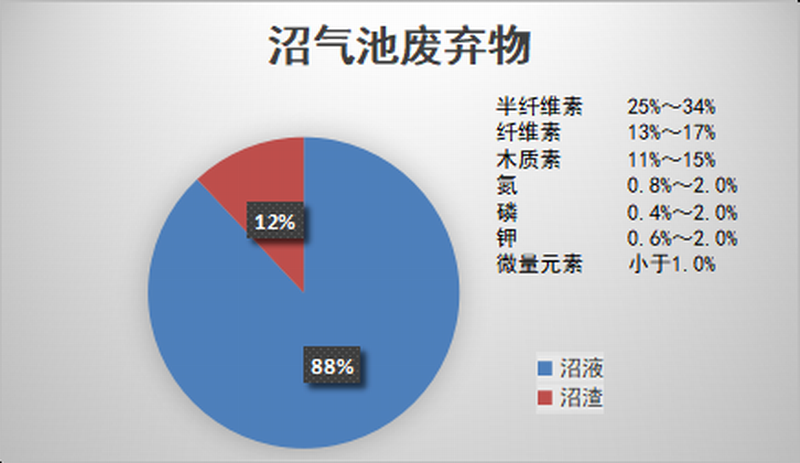Biogas fertilizer, or biogas fermentation fertilizer, refers to the waste formed by organic matter such as crop straw and human and animal manure urine in biogas digesters after gas-weary fermentation.
Biogas fertilizer has two forms:
First, biogas fertilizer - biogas, accounting for about 88% of the total fertilizer.
Second, solid residue - biogas, accounting for about 12% of the total fertilizer.
The biogas contains nutrients such as quick-acting nitrogen, phosphorus and potassium, as well as trace elements such as zinc and iron. It was determined that the biogas contained 0.062% to 0.11% of total nitrogen, ammonium nitrogen was 200 to 600 mg/kg, quick-acting phosphorus was 20 to 90 mg/kg, and quick-acting potassium was 400 to 1100 mg/kg. Because of its quick-acting, high utilization rate of nutrients, can be quickly absorbed and used by crops, is a better multi-quick-acting compound fertilizer. The nutritional elements of solid slag fertilizer are basically the same as 20% and biogas, containing 30% to 50% of the machine, 0.8% to 1.5% of nitrogen, 0.4% to 0.6% of phosphorus, 0.6% to 1.2% of potassium, and more than 11% rich in humic acid. Humic acid can promote the formation of soil granules structure, enhance soil fertilization performance and buffering force, improve soil physiochemical properties to improve soil effect is very obvious. The nature of biogas fertilizer is the same as that of general organic fertilizer, which is the best long-term use of late-effect fertilizer.
Biogas fertilizer should be precipitated for a period of time - secondary fermentation, so that solid liquid natural separation. It is also possible to separate biogas-liquid biogas and slag-solid biogas by solid-liquid separator.

Waste after the first fermentation of the biogas digester is first separated by a solid-liquid separator. The separation fluid is then pumped into the reactor to separate the phytic acid reaction. Then the rotting phytic acid reaction liquid is added to other fertilizer elements for the network reaction, after the full reaction is the finished product and packaging.
Equipment for the production of biogas waste liquid organic fertilizer.
1. Aeration pool.
2. Solid-liquid separator.
3. Reactor.
4. Enter the pump.
5. Blowing fan.
6. Storage tanks.
7. Mating fill lines.
The technical difficulty of biogas fertilizer.
Solid-liquid separation.
Deodorize.
Chelating technology.
Solid-liquid separator.
The use of solid-liquid separators to separate biogas and biogas has high production capacity, simple operation, easy maintenance, reasonable price and so on.
Solutions for difficulties.
Aeration pool.
The biological deodorization method is adopted, and the deodorization process combined with the aeration pool has obvious effect.
Improve management capabilities.
Select the right production line and equipment to improve line management capabilities. Work efficiency increases by 10% to 25% with tight chelation operation processes and system management. The quality of the finished product has been tested in a variety of formulations to meet international standards.
The advantages of biogas waste fertilizer.
1. Nutrition completely meets the needs of nutrients at different times of the crop, and enhances the absorption and utilization of nutrients.
2. Promote crop growth, photosynthing, transport and continuous release.
3. Improve crop immunity to reduce the lack of trace elements caused by small leaves, yellow leaves, dead trees and other physiological diseases.
4. It can promote root development and seedling, regulate the opening of pores to reduce the vapor effect, enhance the crop drought, dry hot air and cold drought resistance.
5. Reduction of chemical damage to crops, herbicides, hail, cold, waterlogging, cultivation and wasteland has been significantly rapid recovery.
6. It can increase the pollination rate, solidity rate, fruit yield, cephalosporine volume and the number of full grains in the crop. As a result, it increases fruit, spike and grain weight, yielding more than 10% to 20%.
7. There are other special effects. It has an aversion effect on sucking pests such as aphids and flying lice.
Post time: Sep-22-2020

